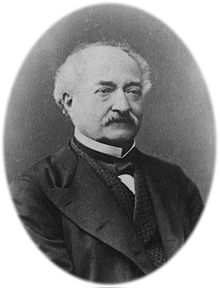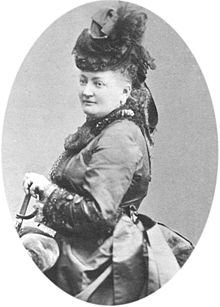You can help expand this article with text translated from the corresponding article in French. (September 2011) Click for important translation instructions.
|
| François Blanc | |
|---|---|
 | |
| Born | (1806-12-12)12 December 1806 Courthézon |
| Died | 27 July 1877(1877-07-27) (aged 70) Loèche-les-Bains |
| Nationality | French |
| Occupation(s) | Businessman, Property developer |
| Spouse(s) | Madeleine-Victoire Huguelin Marie Charlotte Hensel |
| Children | Camille Blanc Charles Blanc Louise Blanc Edmond Blanc Marie-Félix Blanc |
| Relatives | Princess Marie Bonaparte (granddaughter) |
François Blanc (French: [fʁɑ̃swa blɑ̃]; 12 December 1806 – 27 July 1877), nicknamed "The Magician of Homburg" and "The Magician of Monte Carlo", was a French entrepreneur and operator of casinos, including the Monte Carlo Casino in Monaco. His daughter, Marie-Félix, married Prince Roland Bonaparte.
Early life
François and his twin brother Louis were born on 12 December 1806. Growing up in a small town, they were impressed every time a circus came to town. The show seemed so interesting and simple, so they followed the circus to learn all the tricks of the trade. The boys were dreaming of becoming rich and successful and learned much by working different jobs.
Career

The brothers started to work in gambling businesses in Marseilles and earned some money. They then decided to develop their own business and started to speculate in government pensions and real estate development. They soon attracted attention to their business and were arrested, but their sentence was short, because laws had not been adopted yet for such cases. They were released and moved to Paris, but after King Louis Philippe passed new laws, they had to move again - to Luxembourg. They ran a profitable business there but it was just a stepping stone to their success in Hesse-Homburg near Frankfurt, where the brothers signed a contract with the Landgrave to help service the debts of the city and to develop the tourism industry.
One innovation was the introduction of the single 0 style roulette wheel in 1843. This allowed Bad Homburg to compete against the casinos of Paris which offered the traditional wheel with both single and double zero house pockets. Local legend says that François Blanc supposedly bargained with the devil to obtain the secrets of roulette. The legend is based on the fact that the sum of all the numbers on the roulette wheel (from 0 to 36) is 666, which is the "Number of the Beast".
The venture was a great success, Homburg became popular overnight with lots of entertainment, gambling houses, and hotels - the rich and famous came there for a new diversion and fun. In a while François Blanc earned the nickname "The Magician of Homburg".
Homburg could attract visitors only in the summer months, as during the winter tourists preferred to travel to warmer places. This gave François the idea to move South and open a year-round business.
It happened that Charles III, Prince of Monaco had recently legalized gambling, so "The Magician of Homburg" became the first person to establish a casino operation in Monaco. To establish Monaco as a gambling mecca for the elite of Europe, he invested in roads and railways to facilitate travel to Monaco as a new place of rest and relaxation. The Prince gave François the freedom he needed to be successful, so he turned from "The Magician of Homburg" to "The Magician of Monte Carlo" and left his mark on the history of Monaco.
Personal life

Blanc was twice married. His first wife was Madeleine-Victoire Huguelin (1823–1852). Together, they were the parents of:
- Camille Blanc (1847–1927), who married Elisabeth Lanxade (b. 1852) in 1885.
- Charles Blanc (1848–1872), who died aged 24.
After the death of his first wife, he remarried to Marie Charlotte Hensel (1833–1881), with whom he had:
- Louise Blanc (1854–1911), who married Prince Constantine Wincenty Maria Radziwiłł (1850–1920), a grandson of Prince Antoni Radziwiłł and Princess Louise of Prussia.
- Edmond Blanc (1856–1920), who married Héloïse Marot (b. 1853) and Marthe Galinier (1874–1947).
- Marie-Félix Blanc (1859–1882), who married Prince Roland Bonaparte (1858–1924).
Blanc died in Loèche-les-Bains on 27 July 1877.
Descendants
Through his daughter Louise, he was the grandfather of Louise Adela Radziwiłł (1877–1942) (who married Armand de La Rochefoucauld, duc de Doudeauville, and was the mother of Marie de La Rochefoucauld (1901–1983), who married Henri-Antoine-Marie de Noailles, 11th Prince de Poix) and Prince Léon Radziwiłł, who married Princess Dolores Radziwiłł and Antonine de Gramont.
Through his daughter Marie-Félix, he was the grandfather of Princess Marie Bonaparte (1882–1962), who married Prince George of Greece and Denmark, the second son of George I of Greece and Olga Konstantinovna of Russia, and is remembered chiefly for having once saved the life of the future Emperor of Russia, Nicholas II in 1891 during their visit to Japan together.
References
- The last term in a sequence of partial sums composed of either sequence is 666, the "beast number".
- Mad for Monaco: The Magician of Monte
- Edwards, Anne (1992). The Grimaldis of Monaco: The Centuries of Scandal - The Years of Grace. William Morrow. ISBN 978-0-688-08837-8.
- Bulletin officiel des annonces commerciales (in French). Journaux officiels. 1978. p. 97. Retrieved 12 February 2019.
- Dolph, Charles A. (1927). The real "Lady of the camellias" and other women of quality. Frank-Maurice. pp. 131, 220, 222. Retrieved 12 February 2019.
- Annuaire de la noblesse de France et des maisons souveraines de l'Europe (in French). Bureau de la publication. 1882. p. 275. Retrieved 12 February 2019.
- Radziwill (Fürstin), Marie Dorothea Elisabeth de Castellane; Robilant, Mario Antonio Nicolis di (1934). Lettres de la princesse Radziwill au général de Robilant, 1889-1914: 1908-1914 (in French). N. Zanichelli. Retrieved 9 February 2019.
- Manach, Daniel; Sementéry, Michel (1997). La descendance de Charles X: roi de France (in French). Editions Christian. p. 203. ISBN 9782864960683. Retrieved 12 February 2019.
- The Cambridge Modern History. CUP Archive. 1910. p. 14. Retrieved 12 February 2019.
- Walton, Jean (2001). Fair Sex, Savage Dreams: Race, Psychoanalysis, Sexual Difference. Duke University Press. p. 102. ISBN 9780822326113. Retrieved 12 February 2019.
- Overland Monthly and Out West Magazine. A. Roman and Company. 1900. p. 353. Retrieved 12 February 2019.
- Braude, Mark (2017). Making Monte Carlo: A History of Speculation and Spectacle. Simon and Schuster. p. 80. ISBN 9781476709703. Retrieved 12 February 2019.
- "SON OF MONTE CARLO'S OWNER Prince Leon Radziwill of Paris Paying Us a Visit. His Family Has Contributed Largely to History of Old World". San Francisco Call. 18 March 1903. Retrieved 12 February 2019.
- Bertin, Celia (1982). Marie Bonaparte: A Life. New York: Harcourt Brace Jovanovich. pp. 17–19, 24–25, 64, 66, 82–84, 94, 96–98, 105–106, 120, 136. ISBN 0-15-157252-6.